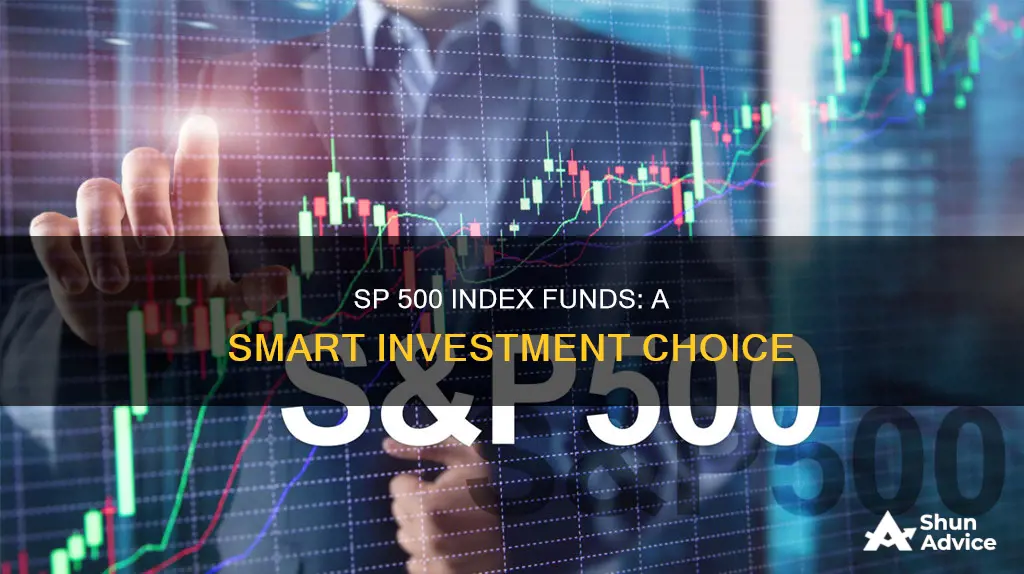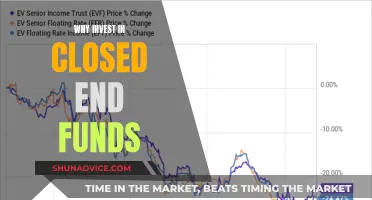
Index funds are a popular investment choice due to their low cost, strong historical performance, and simplicity. The S&P 500 index funds are a great way to diversify your portfolio and get exposure to larger stocks across the U.S. market. The S&P 500 index tracks the prices of the 500 largest U.S. public companies, representing 80% of the market capitalization of the entire U.S. stock market.
When choosing an S&P 500 index fund to invest in, it is important to consider the expense ratio, fund turnover rate, minimum investment requirements, and the fund's track record and manager's reputation. Some of the best S&P 500 index funds in the market include the Fidelity 500 Index Fund, Vanguard 500 Index Fund Admiral Shares, and Schwab S&P 500 Index Fund. These funds offer low expense ratios, no minimum investment requirements, and strong historical performance, making them a great choice for investors looking for a broadly diversified, low-cost investment option.
What You'll Learn

The best S&P 500 index funds
The S&P 500 is a stock market index that measures the performance of about 500 large US companies. Index funds are a great way to invest in the S&P 500, as they are fairly inexpensive compared to other types of mutual funds and can instantly diversify your portfolio. Here are some of the best S&P 500 index funds on the market:
Fidelity ZERO Large Cap Index (FNILX)
This mutual fund from Fidelity does not officially track the S&P 500 but instead follows the Fidelity U.S. Large Cap Index, which is very similar. The main difference is that Fidelity does not have to pay a licensing fee to use the S&P name, which helps keep costs down. This fund has a 0% expense ratio, a 16% 5-year annualized return, and is a great option for investors looking for a broadly diversified index fund at a low cost.
Vanguard S&P 500 ETF (VOO)
The Vanguard S&P 500 ETF is one of the largest funds on the market, with hundreds of billions in the fund. It began trading in 2010 and is backed by Vanguard, one of the most well-known names in the fund industry. This fund has a 0.03% expense ratio and a 16% 5-year annualized return. It is another great option for investors looking for a broadly diversified index fund at a low cost.
SPDR S&P 500 ETF Trust (SPY)
The SPDR S&P 500 ETF is the oldest ETF on the market, having been founded in 1993. It is also one of the most popular, with hundreds of billions in the fund. This fund is sponsored by State Street Global Advisors and has a 0.095% expense ratio and a 15.9% 5-year annualized return. It is a great choice for investors seeking broad diversification and low costs.
IShares Core S&P 500 ETF (IVV)
The iShares Core S&P 500 ETF is sponsored by BlackRock, one of the largest fund companies in the world. This fund has been around since 2000 and has a 0.03% expense ratio and a 16% 5-year annualized return. It is a good option for investors looking for a broadly diversified, low-cost index fund.
Schwab S&P 500 Index Fund (SWPPX)
This mutual fund from Charles Schwab has been around since 1997 and has tens of billions in assets. It has a very low 0.02% expense ratio and a 16% 5-year annualized return. The Schwab S&P 500 Index Fund is a great choice for investors seeking broad diversification and low fees.
Vanguard Index Funds: Best Investment Options for 2023
You may want to see also

The pros and cons of investing in the S&P 500
Investing in the S&P 500 can be a great way to diversify your portfolio and gain exposure to large-cap stocks. Here are some pros and cons to consider before investing:
Pros of Investing in the S&P 500:
- Diversification: The S&P 500 tracks the performance of 500 large US companies across various industries and sectors, providing instant diversification for investors.
- Low Cost: S&P 500 index funds are passively managed, resulting in lower expense ratios compared to actively managed funds. This makes them an attractive option for cost-conscious investors.
- Attractive Returns: Historically, the S&P 500 has delivered solid returns, with an average annualized return of about 10% since its inception in 1957.
- Liquidity: S&P 500 index funds are highly liquid, allowing investors to buy and sell their shares quickly and easily.
- Accessibility: These funds have low minimum investment requirements, making them accessible to a wide range of investors.
Cons of Investing in the S&P 500:
- Risk of Loss: While diversification reduces risk, investing in the stock market always carries the possibility of losing money, especially in the short term.
- Taxes: Profits from selling stocks are subject to capital gains taxes, reducing your overall returns.
- Emotional Ups and Downs: The stock market can be volatile, and it can be challenging for investors to avoid making impulsive decisions based on fear or greed.
- Competition: Institutional and professional investors have more resources, knowledge, and tools at their disposal, which can put individual investors at a disadvantage.
- Time Commitment: Investing in stocks requires researching and monitoring companies and the market, which can be time-consuming.
Ethical Investment Funds: Choosing the Right Option
You may want to see also

How to invest in the S&P 500
The S&P 500 is a stock market index that reflects economic trends and captures about 80% of the available market capitalization. It is made up of 500 of the largest U.S. companies listed on the New York Stock Exchange or the Nasdaq exchange.
Step 1: Understand the S&P 500
Get to know how the S&P 500 works, including the upside opportunities and downside risks it brings to portfolio performance. The S&P 500 is not designed to beat the broader stock market but to match it.
Step 2: Pick a Broker
If you are new to investing, choose a brokerage account that offers funds with no-load fees and low expense ratios. Do your research to find the most value for the cheapest price.
Step 3: Choose Your Fund
Review the fund's objective, prospectus, and performance. Consider the time period you want to invest in and the overall market trends. Analyze the fund's historical cumulative returns, portfolio turnover, and volatility metrics.
Step 4: Determine Your Investment Strategy
Decide how you want to invest in the S&P 500. You can invest through an exchange-traded fund (ETF), an index fund, or individual stocks. ETFs and index funds are more passive investment strategies, whereas investing in individual stocks requires more research and a deeper understanding of specific companies.
Step 5: Make Your Trades
Use your chosen investing account to place your trades. Specify the number of shares or the dollar amount you want to invest.
Step 6: Monitor and Rebalance Your Investments
Keep an eye on your investments and review them periodically to ensure your portfolio remains diversified. Rebalance your holdings if necessary to maintain your desired asset allocation.
Which Index Funds to Invest in the S&P 500
When choosing an S&P 500 index fund, consider the expense ratio, minimum investment, dividend yield, and inception date. Here are some of the best S&P 500 index funds in the market:
- Vanguard 500 Index Fund - Admiral Shares (VFIAX)
- Schwab S&P 500 Index Fund (SWPPX)
- Fidelity Zero Large Cap Index (FNILX)
- Fidelity 500 Index Fund (FXAIX)
- T. Rowe Price Equity Index 500 Fund (PREIX)
- Vanguard S&P 500 ETF (VOO)
- SPDR S&P 500 ETF Trust (SPY)
- IShares Core S&P 500 ETF (IVV)
Tax-Exempt Bond Funds: When to Invest for Maximum Returns
You may want to see also

The best S&P 500 ETFs
S&P 500 index funds are a great way to round out most investment portfolios. They are popular because they can instantly diversify a portfolio. With a single asset, you are invested in 500 of the largest companies in the U.S., covering many types of industries and sectors.
Vanguard S&P 500 ETF (VOO)
This ETF began trading in 2010 and is backed by Vanguard, a powerhouse in the fund industry. With an expense ratio of 0.03%, it is a great option for investors looking for a broadly diversified index fund at a low cost.
SPDR S&P 500 ETF Trust (SPY)
The SPDR S&P 500 ETF is the granddaddy of ETFs, founded in 1993. It helped kick off the wave of ETF investing that has become so popular today. With an expense ratio of 0.095%, it is still one of the most popular ETFs on the market.
IShares Core S&P 500 ETF (IVV)
This fund is sponsored by BlackRock, one of the largest fund companies. With an inception date of 2000, this fund has a long track record of closely tracking the S&P 500 index. It has an expense ratio of 0.03%, making it a low-cost option for investors.
Schwab S&P 500 Index Fund (SWPPX)
This mutual fund has been around since 1997 and is sponsored by Charles Schwab, one of the most respected names in the industry. Schwab is known for its investor-friendly products, as evidenced by this fund's razor-thin expense ratio of 0.02%.
Fidelity 500 Index (FXAIX)
This S&P 500 index fund from Fidelity is actually cheaper than several similar S&P 500 ETFs, making it one of the most cost-effective options for tracking this popular benchmark of large U.S. stocks. With no minimums on the initial investment, it is accessible to almost every investor.
Vanguard 500 Index Admiral Fund (VFIAX)
While this Vanguard fund has an investment minimum and a higher fee structure than some of the others, it still has more assets than many of the smaller S&P 500 index funds combined. If Vanguard is your go-to platform for mutual funds, you can invest in this fund with confidence.
Mutual Funds: Where Are Your Investments Going?
You may want to see also

The best S&P 500 index funds for beginners
S&P 500 index funds are a great way for beginners to invest in the stock market. By investing in these funds, you get instant diversification across hundreds of large US companies from various industries and sectors. Here are some of the best S&P 500 index funds for beginners:
Vanguard S&P 500 ETF (VOO)
Backed by Vanguard, a powerhouse in the fund industry, this exchange-traded fund (ETF) tracks the S&P 500 index. With hundreds of billions in assets and an expense ratio of just 0.03%, it's an excellent choice for investors looking for broad diversification at an extremely low cost.
SPDR S&P 500 ETF Trust (SPY)
The SPDR S&P 500 ETF is one of the oldest and most popular ETFs, founded in 1993. It is sponsored by State Street Global Advisors and has hundreds of billions in assets. With an expense ratio of 0.095%, it's a great option for investors seeking broad diversification at a competitive price.
IShares Core S&P 500 ETF (IVV)
Sponsored by BlackRock, one of the largest fund companies, this ETF has been tracking the S&P 500 since 2000. With an expense ratio of 0.03%, it's another excellent choice for investors seeking broad market exposure at a low cost.
Schwab S&P 500 Index Fund (SWPPX)
Sponsored by Charles Schwab, a well-respected name in the industry, this mutual fund has been around since 1997. With tens of billions in assets and an ultra-low expense ratio of 0.02%, it's perfect for investors seeking a broadly diversified fund with minimal fees.
Fidelity ZERO Large Cap Index (FNILX)
This mutual fund from Fidelity does not officially track the S&P 500 but instead follows the Fidelity U.S. Large Cap Index. However, the difference is negligible, and this fund offers the advantage of having a 0% expense ratio, meaning no fees for investors. It's an excellent choice for investors seeking broad diversification with absolutely no costs.
When choosing an S&P 500 index fund, beginners should consider factors such as the fund's expense ratio, investment minimum, performance history, and the fund provider's reputation. These funds provide instant diversification and are excellent core holdings for any investment portfolio.
Banks' Investment Strategies: Where Do They Invest Deposits?
You may want to see also
Frequently asked questions
An S&P 500 index fund tracks the S&P 500, a market index that measures the performance of about 500 U.S. companies.
The best S&P 500 index fund for you will depend on its minimum investment, costs, and how closely it aligns with the S&P 500 market index. Some of the best S&P 500 index funds on the market include Vanguard 500 Index Fund - Admiral Shares (VFIAX), Schwab S&P 500 Index Fund (SWPPX), Fidelity Zero Large Cap Index (FNILX), Fidelity 500 Index Fund (FXAIX), and T. Rowe Price Equity Index 500 Fund (PREIX).
Because the underlying investment is the same for any S&P 500 index fund, you'll get very similar returns with any fund you choose. To choose a fund, look for one with low fees and one that doesn't require a large minimum investment.







